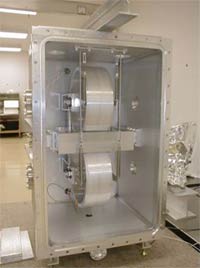
Handy Links
SLAC News Center
SLAC Today
- Subscribe
- Archives: Feb 2006-May 20, 2011
- Archives: May 23, 2011 and later
- Submit Feedback or Story Ideas
- About SLAC Today
SLAC News
Lab News
- Interactions
- Lightsources.org
- ILC NewsLine
- Int'l Science Grid This Week
- Fermilab Today
- Berkeley Lab News
- @brookhaven TODAY
- DOE Pulse
- CERN Courier
- DESY inForm
- US / LHC
SLAC Links
- Emergency
- Safety
- Policy Repository
- Site Entry Form

- Site Maps
- M & O Review
- Computing Status & Calendar
- SLAC Colloquium
- SLACspeak
- SLACspace
- SLAC Logo
- Café Menu
- Flea Market
- Web E-mail
- Marguerite Shuttle
- Discount Commuter Passes
-
Award Reporting Form
- SPIRES
- SciDoc
- Activity Groups
- Library
Stanford
Around the Bay
SLAC's LARP Phase II Collimator Program
 When Jim Strait of Fermilab gave a
seminar at SLAC in 2003 about technical challenges at the Large Hadron Collider (LHC) as part of the
SLAC Scenarios series, he highlighted the issue of LHC collimation. Collimators are blocks of material that form small openings through which a beam must pass. They scrape away beam tails, delivering only the clean core of the beam to experiments, and, as the tightest hole in the transport line, protect more easily damaged devices.
When Jim Strait of Fermilab gave a
seminar at SLAC in 2003 about technical challenges at the Large Hadron Collider (LHC) as part of the
SLAC Scenarios series, he highlighted the issue of LHC collimation. Collimators are blocks of material that form small openings through which a beam must pass. They scrape away beam tails, delivering only the clean core of the beam to experiments, and, as the tightest hole in the transport line, protect more easily damaged devices.
In the LHC collimation system, the 7 TeV 350 MegaJoule proton beam—energetic enough to melt 1,000 pounds of copper—will pass through a series of adjustable ~3 millimeter wide gaps formed by the edges, or jaws, of ~1 meter long blocks. In normal operation the jaws must stay aligned to the level of 25 microns, the diameter of a human hair, while efficiently removing 90 kW of errant protons, twice the beam power of the SLAC Linear Collider (SLC).
As if that wasn't enough, Jim's challenge was to come up with a scheme to deal with the rare, but eventual, problem of the accidental pre-firing of the fully-energized beam abort kicker magnet system, which would slam a MegaJoule of protons into a jaw in 200 nanoseconds. This photo shows what about half a MegaJoule of 16 GeV electrons can do to a 1 meter long block of copper, a typical material for collimator jaws.
As it happens, the pre-ILC X-band e+e- linear collider under development at SLAC until 2004 had a similar collimator damage challenge. After investigating several approaches, Joe Frisch proposed a design based on rotatable metal cylinder jaws, which Eric Doyle then prototyped and tested (see above image). If errant beam damaged the surface, the cylinder jaws would be rotated a bit to present a clean new surface to the beam. What began as a simple suggestion in 2003 that the LHC adopt a similar design, has led to SLAC joining U.S. LARP, the LHC Accelerator Research Program, with the task of designing and building a prototype "Phase II Collimator" for delivery to CERN in 2009.
The LHC is being equipped for start up operation with a collimation system based on rectangular carbon jaws. The carbon is sufficiently transparent that it will survive a beam abort system misfire, but lacks the resistivity and efficiency needed for the LHC to achieve its design luminosity. Empty slots have been left in the LHC lattice for improved "Phase II" collimators.
Doyle, along with Steve Lundgren, Gene Anzalone, Lew Keller, Yunhai Cai and Tom Markiewicz have designed and calculated the performance characteristics of a rotatable 1-meter long 14-centimeter diameter copper jaw with 12 kilowatts of cooling capacity that should meet the LHC's requirements and provide enough circumference for 20 accidents. The design relies heavily on SLAC's manufacturing expertise and the SLAC klystron department's superb brazing skills. Small test pieces of the jaw have been used to verify the design and manufacturing procedures and construction of the first full-length jaw is in progress. Thermal-mechanical tests will begin this fall. If beam tests in 2009 show that the SLAC design can handle the challenge, CERN will construct 32 devices from our plans and install them in the LHC, where SLAC staff will help commission them.
—Tom Markiewicz
SLAC Today, September 7, 2006
Above image: These rotatable metal cylinder jaws were originally designed by Joe Frisch and prototyped and tested by Eric Doyle. (Click on image for larger version.)